Environmental Science Report: Sustainable Plastic Recycling Methods
VerifiedAdded on 2020/05/28
|16
|3951
|65
Report
AI Summary
This report examines the critical issue of plastic recycling and its environmental impact. It begins with an executive summary outlining the problem of plastic pollution and the need for sustainable solutions. The report investigates the usage and disposal of plastics, highlighting their contribution to environmental pollution and the health hazards associated with their manufacturing and decomposition. It explores research questions focusing on sustainable recycling methods, technological advancements, and the role of government. The methodology involves secondary research, analyzing online sources, and addressing challenges in data collection. The findings discuss the harmful effects of plastics, the need for sustainable recycling, and the role of technology in developing biodegradable plastics and energy recovery methods. The report concludes with implications for adopting sustainable practices, links to the Australian Curriculum, and a comprehensive list of references. The primary goal of this report is to provide a comprehensive understanding of the impacts of plastics, plastic recycling, and the importance of adopting sustainable procedures to lessen the adverse impact on the ecosystem.
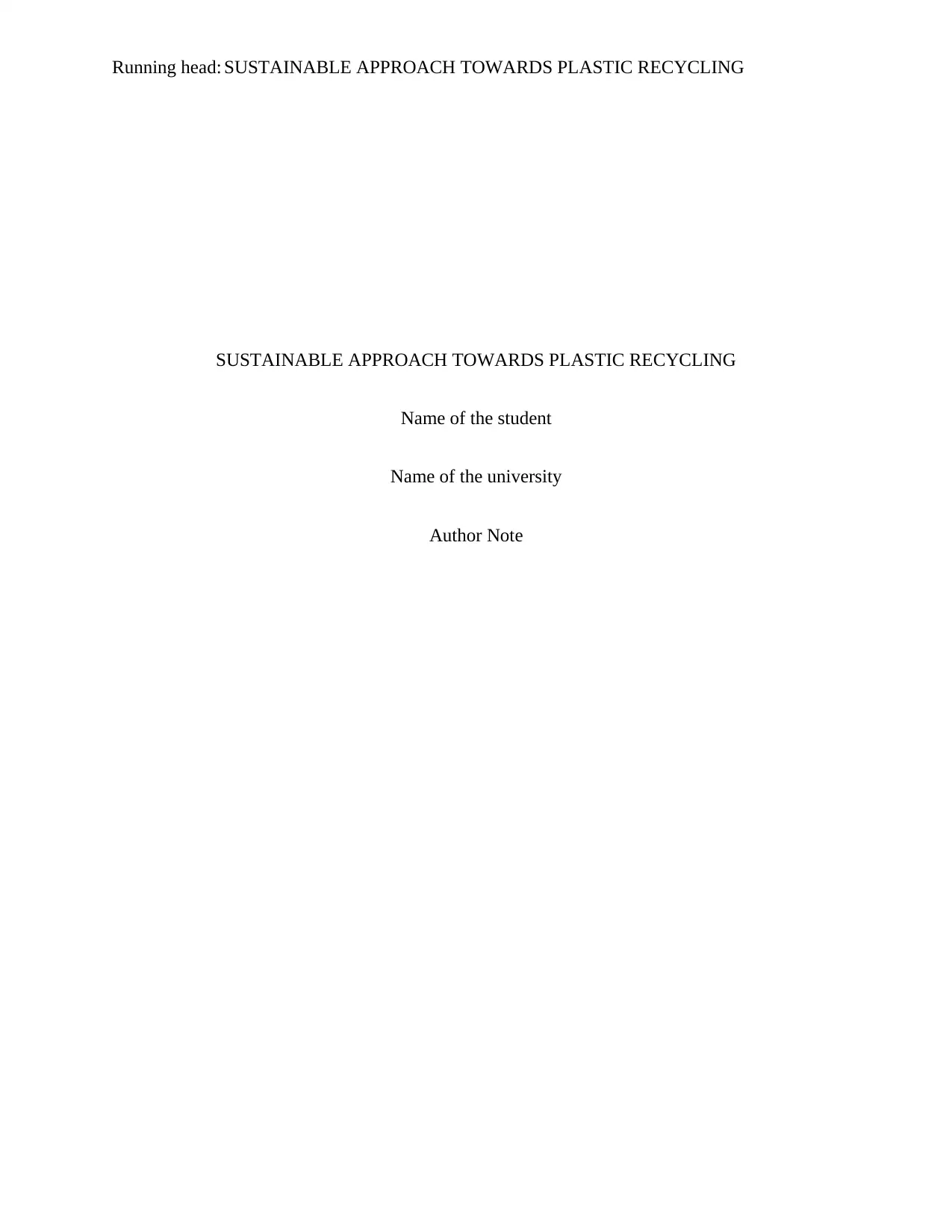
Running head: SUSTAINABLE APPROACH TOWARDS PLASTIC RECYCLING
SUSTAINABLE APPROACH TOWARDS PLASTIC RECYCLING
Name of the student
Name of the university
Author Note
SUSTAINABLE APPROACH TOWARDS PLASTIC RECYCLING
Name of the student
Name of the university
Author Note
Paraphrase This Document
Need a fresh take? Get an instant paraphrase of this document with our AI Paraphraser
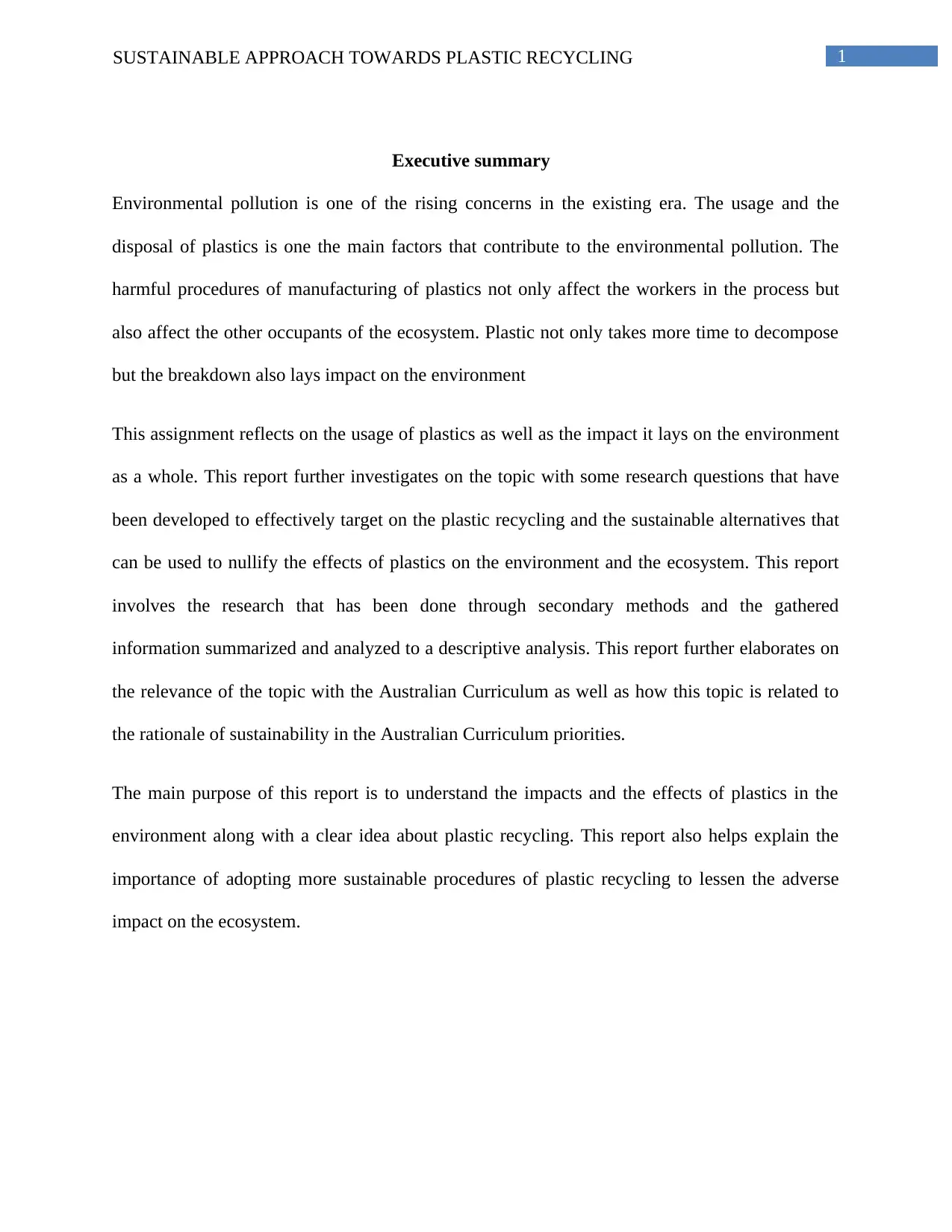
1SUSTAINABLE APPROACH TOWARDS PLASTIC RECYCLING
Executive summary
Environmental pollution is one of the rising concerns in the existing era. The usage and the
disposal of plastics is one the main factors that contribute to the environmental pollution. The
harmful procedures of manufacturing of plastics not only affect the workers in the process but
also affect the other occupants of the ecosystem. Plastic not only takes more time to decompose
but the breakdown also lays impact on the environment
This assignment reflects on the usage of plastics as well as the impact it lays on the environment
as a whole. This report further investigates on the topic with some research questions that have
been developed to effectively target on the plastic recycling and the sustainable alternatives that
can be used to nullify the effects of plastics on the environment and the ecosystem. This report
involves the research that has been done through secondary methods and the gathered
information summarized and analyzed to a descriptive analysis. This report further elaborates on
the relevance of the topic with the Australian Curriculum as well as how this topic is related to
the rationale of sustainability in the Australian Curriculum priorities.
The main purpose of this report is to understand the impacts and the effects of plastics in the
environment along with a clear idea about plastic recycling. This report also helps explain the
importance of adopting more sustainable procedures of plastic recycling to lessen the adverse
impact on the ecosystem.
Executive summary
Environmental pollution is one of the rising concerns in the existing era. The usage and the
disposal of plastics is one the main factors that contribute to the environmental pollution. The
harmful procedures of manufacturing of plastics not only affect the workers in the process but
also affect the other occupants of the ecosystem. Plastic not only takes more time to decompose
but the breakdown also lays impact on the environment
This assignment reflects on the usage of plastics as well as the impact it lays on the environment
as a whole. This report further investigates on the topic with some research questions that have
been developed to effectively target on the plastic recycling and the sustainable alternatives that
can be used to nullify the effects of plastics on the environment and the ecosystem. This report
involves the research that has been done through secondary methods and the gathered
information summarized and analyzed to a descriptive analysis. This report further elaborates on
the relevance of the topic with the Australian Curriculum as well as how this topic is related to
the rationale of sustainability in the Australian Curriculum priorities.
The main purpose of this report is to understand the impacts and the effects of plastics in the
environment along with a clear idea about plastic recycling. This report also helps explain the
importance of adopting more sustainable procedures of plastic recycling to lessen the adverse
impact on the ecosystem.
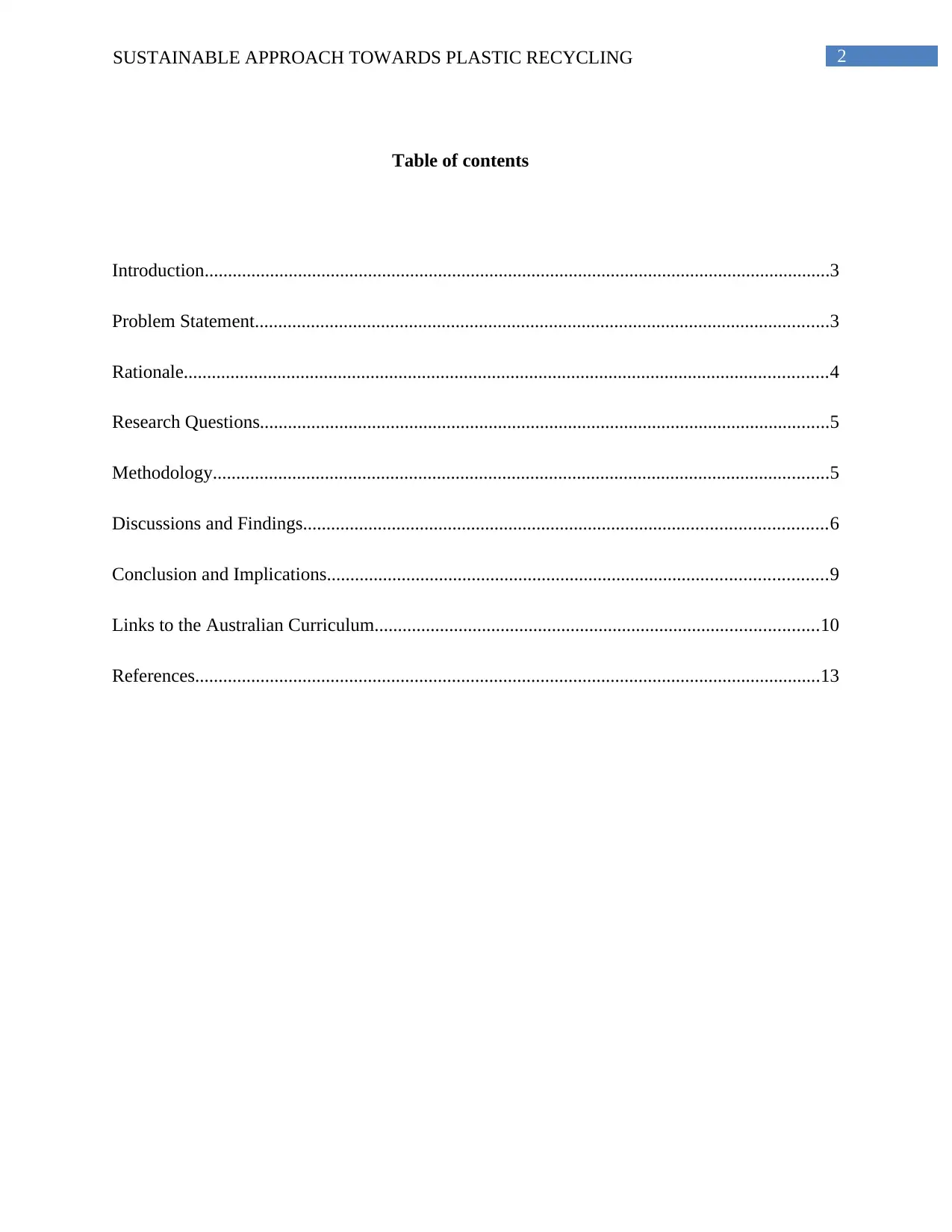
2SUSTAINABLE APPROACH TOWARDS PLASTIC RECYCLING
Table of contents
Introduction......................................................................................................................................3
Problem Statement...........................................................................................................................3
Rationale..........................................................................................................................................4
Research Questions..........................................................................................................................5
Methodology....................................................................................................................................5
Discussions and Findings................................................................................................................6
Conclusion and Implications...........................................................................................................9
Links to the Australian Curriculum...............................................................................................10
References......................................................................................................................................13
Table of contents
Introduction......................................................................................................................................3
Problem Statement...........................................................................................................................3
Rationale..........................................................................................................................................4
Research Questions..........................................................................................................................5
Methodology....................................................................................................................................5
Discussions and Findings................................................................................................................6
Conclusion and Implications...........................................................................................................9
Links to the Australian Curriculum...............................................................................................10
References......................................................................................................................................13
⊘ This is a preview!⊘
Do you want full access?
Subscribe today to unlock all pages.

Trusted by 1+ million students worldwide
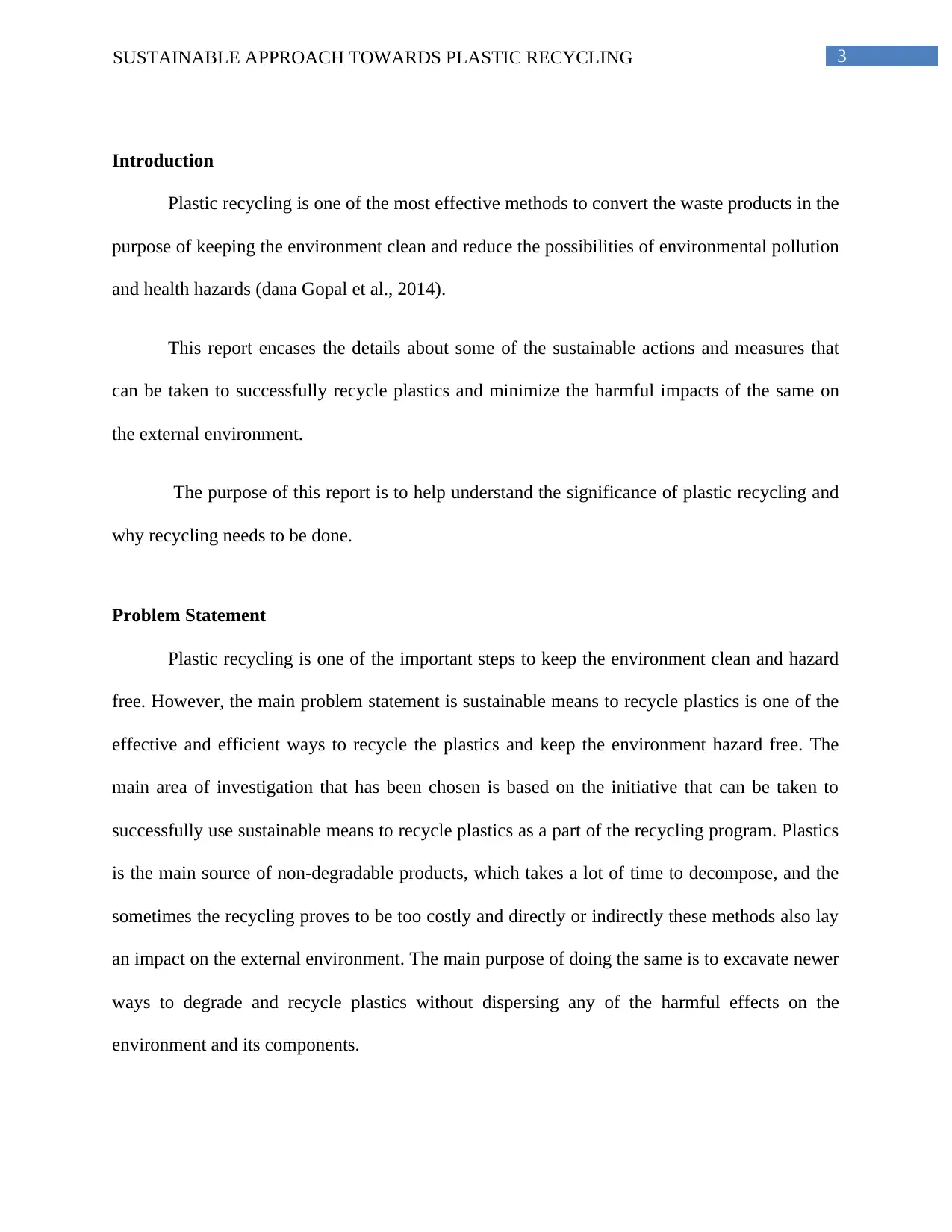
3SUSTAINABLE APPROACH TOWARDS PLASTIC RECYCLING
Introduction
Plastic recycling is one of the most effective methods to convert the waste products in the
purpose of keeping the environment clean and reduce the possibilities of environmental pollution
and health hazards (dana Gopal et al., 2014).
This report encases the details about some of the sustainable actions and measures that
can be taken to successfully recycle plastics and minimize the harmful impacts of the same on
the external environment.
The purpose of this report is to help understand the significance of plastic recycling and
why recycling needs to be done.
Problem Statement
Plastic recycling is one of the important steps to keep the environment clean and hazard
free. However, the main problem statement is sustainable means to recycle plastics is one of the
effective and efficient ways to recycle the plastics and keep the environment hazard free. The
main area of investigation that has been chosen is based on the initiative that can be taken to
successfully use sustainable means to recycle plastics as a part of the recycling program. Plastics
is the main source of non-degradable products, which takes a lot of time to decompose, and the
sometimes the recycling proves to be too costly and directly or indirectly these methods also lay
an impact on the external environment. The main purpose of doing the same is to excavate newer
ways to degrade and recycle plastics without dispersing any of the harmful effects on the
environment and its components.
Introduction
Plastic recycling is one of the most effective methods to convert the waste products in the
purpose of keeping the environment clean and reduce the possibilities of environmental pollution
and health hazards (dana Gopal et al., 2014).
This report encases the details about some of the sustainable actions and measures that
can be taken to successfully recycle plastics and minimize the harmful impacts of the same on
the external environment.
The purpose of this report is to help understand the significance of plastic recycling and
why recycling needs to be done.
Problem Statement
Plastic recycling is one of the important steps to keep the environment clean and hazard
free. However, the main problem statement is sustainable means to recycle plastics is one of the
effective and efficient ways to recycle the plastics and keep the environment hazard free. The
main area of investigation that has been chosen is based on the initiative that can be taken to
successfully use sustainable means to recycle plastics as a part of the recycling program. Plastics
is the main source of non-degradable products, which takes a lot of time to decompose, and the
sometimes the recycling proves to be too costly and directly or indirectly these methods also lay
an impact on the external environment. The main purpose of doing the same is to excavate newer
ways to degrade and recycle plastics without dispersing any of the harmful effects on the
environment and its components.
Paraphrase This Document
Need a fresh take? Get an instant paraphrase of this document with our AI Paraphraser
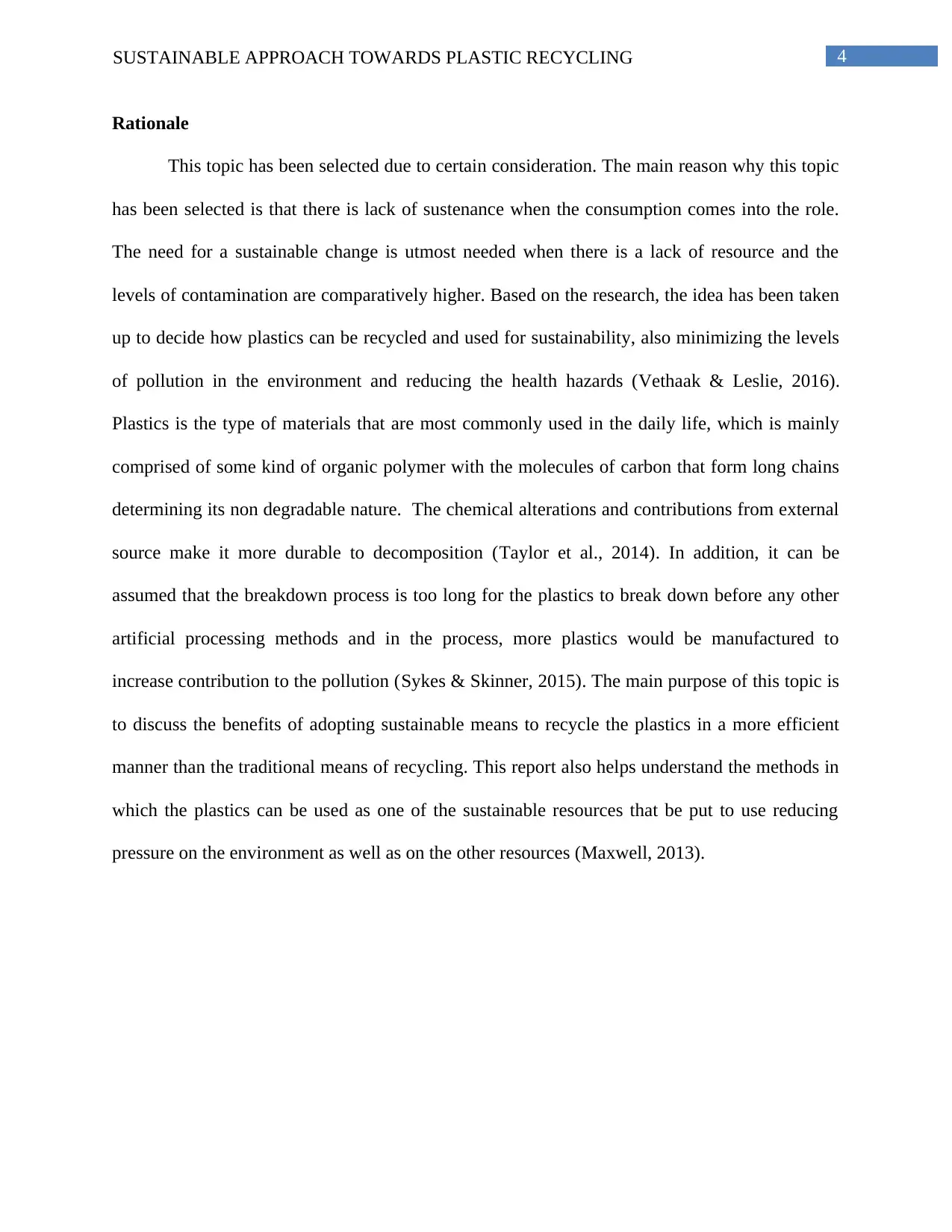
4SUSTAINABLE APPROACH TOWARDS PLASTIC RECYCLING
Rationale
This topic has been selected due to certain consideration. The main reason why this topic
has been selected is that there is lack of sustenance when the consumption comes into the role.
The need for a sustainable change is utmost needed when there is a lack of resource and the
levels of contamination are comparatively higher. Based on the research, the idea has been taken
up to decide how plastics can be recycled and used for sustainability, also minimizing the levels
of pollution in the environment and reducing the health hazards (Vethaak & Leslie, 2016).
Plastics is the type of materials that are most commonly used in the daily life, which is mainly
comprised of some kind of organic polymer with the molecules of carbon that form long chains
determining its non degradable nature. The chemical alterations and contributions from external
source make it more durable to decomposition (Taylor et al., 2014). In addition, it can be
assumed that the breakdown process is too long for the plastics to break down before any other
artificial processing methods and in the process, more plastics would be manufactured to
increase contribution to the pollution (Sykes & Skinner, 2015). The main purpose of this topic is
to discuss the benefits of adopting sustainable means to recycle the plastics in a more efficient
manner than the traditional means of recycling. This report also helps understand the methods in
which the plastics can be used as one of the sustainable resources that be put to use reducing
pressure on the environment as well as on the other resources (Maxwell, 2013).
Rationale
This topic has been selected due to certain consideration. The main reason why this topic
has been selected is that there is lack of sustenance when the consumption comes into the role.
The need for a sustainable change is utmost needed when there is a lack of resource and the
levels of contamination are comparatively higher. Based on the research, the idea has been taken
up to decide how plastics can be recycled and used for sustainability, also minimizing the levels
of pollution in the environment and reducing the health hazards (Vethaak & Leslie, 2016).
Plastics is the type of materials that are most commonly used in the daily life, which is mainly
comprised of some kind of organic polymer with the molecules of carbon that form long chains
determining its non degradable nature. The chemical alterations and contributions from external
source make it more durable to decomposition (Taylor et al., 2014). In addition, it can be
assumed that the breakdown process is too long for the plastics to break down before any other
artificial processing methods and in the process, more plastics would be manufactured to
increase contribution to the pollution (Sykes & Skinner, 2015). The main purpose of this topic is
to discuss the benefits of adopting sustainable means to recycle the plastics in a more efficient
manner than the traditional means of recycling. This report also helps understand the methods in
which the plastics can be used as one of the sustainable resources that be put to use reducing
pressure on the environment as well as on the other resources (Maxwell, 2013).
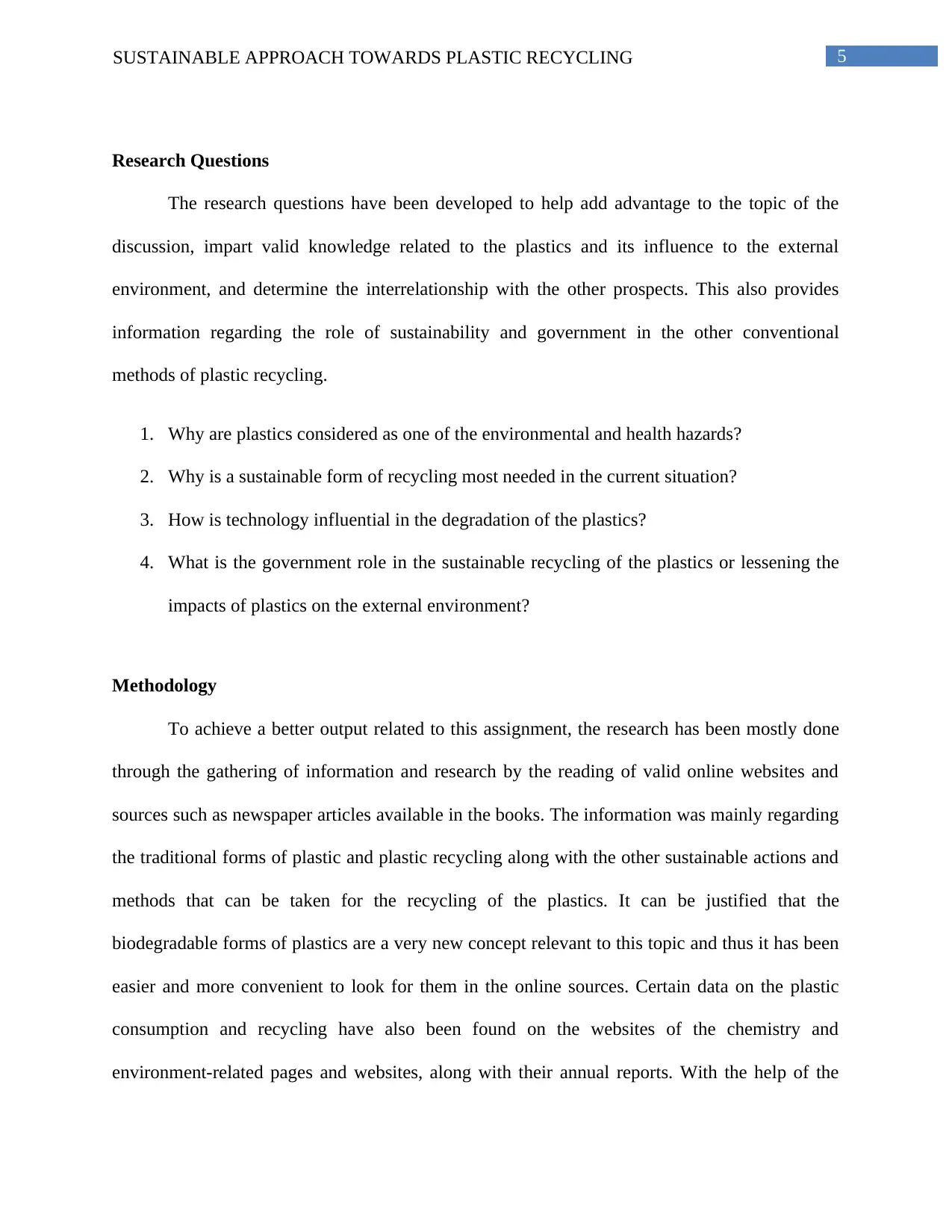
5SUSTAINABLE APPROACH TOWARDS PLASTIC RECYCLING
Research Questions
The research questions have been developed to help add advantage to the topic of the
discussion, impart valid knowledge related to the plastics and its influence to the external
environment, and determine the interrelationship with the other prospects. This also provides
information regarding the role of sustainability and government in the other conventional
methods of plastic recycling.
1. Why are plastics considered as one of the environmental and health hazards?
2. Why is a sustainable form of recycling most needed in the current situation?
3. How is technology influential in the degradation of the plastics?
4. What is the government role in the sustainable recycling of the plastics or lessening the
impacts of plastics on the external environment?
Methodology
To achieve a better output related to this assignment, the research has been mostly done
through the gathering of information and research by the reading of valid online websites and
sources such as newspaper articles available in the books. The information was mainly regarding
the traditional forms of plastic and plastic recycling along with the other sustainable actions and
methods that can be taken for the recycling of the plastics. It can be justified that the
biodegradable forms of plastics are a very new concept relevant to this topic and thus it has been
easier and more convenient to look for them in the online sources. Certain data on the plastic
consumption and recycling have also been found on the websites of the chemistry and
environment-related pages and websites, along with their annual reports. With the help of the
Research Questions
The research questions have been developed to help add advantage to the topic of the
discussion, impart valid knowledge related to the plastics and its influence to the external
environment, and determine the interrelationship with the other prospects. This also provides
information regarding the role of sustainability and government in the other conventional
methods of plastic recycling.
1. Why are plastics considered as one of the environmental and health hazards?
2. Why is a sustainable form of recycling most needed in the current situation?
3. How is technology influential in the degradation of the plastics?
4. What is the government role in the sustainable recycling of the plastics or lessening the
impacts of plastics on the external environment?
Methodology
To achieve a better output related to this assignment, the research has been mostly done
through the gathering of information and research by the reading of valid online websites and
sources such as newspaper articles available in the books. The information was mainly regarding
the traditional forms of plastic and plastic recycling along with the other sustainable actions and
methods that can be taken for the recycling of the plastics. It can be justified that the
biodegradable forms of plastics are a very new concept relevant to this topic and thus it has been
easier and more convenient to look for them in the online sources. Certain data on the plastic
consumption and recycling have also been found on the websites of the chemistry and
environment-related pages and websites, along with their annual reports. With the help of the
⊘ This is a preview!⊘
Do you want full access?
Subscribe today to unlock all pages.

Trusted by 1+ million students worldwide
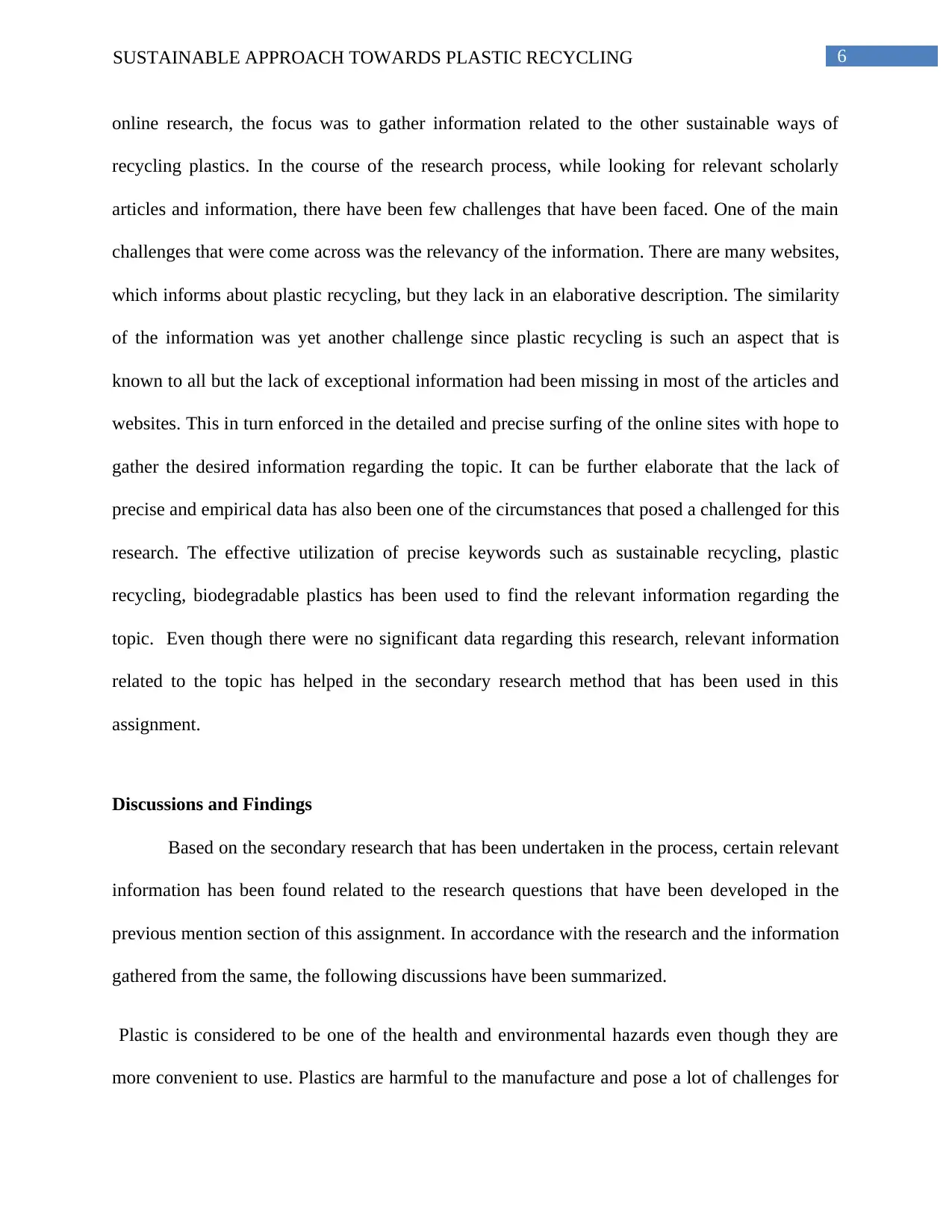
6SUSTAINABLE APPROACH TOWARDS PLASTIC RECYCLING
online research, the focus was to gather information related to the other sustainable ways of
recycling plastics. In the course of the research process, while looking for relevant scholarly
articles and information, there have been few challenges that have been faced. One of the main
challenges that were come across was the relevancy of the information. There are many websites,
which informs about plastic recycling, but they lack in an elaborative description. The similarity
of the information was yet another challenge since plastic recycling is such an aspect that is
known to all but the lack of exceptional information had been missing in most of the articles and
websites. This in turn enforced in the detailed and precise surfing of the online sites with hope to
gather the desired information regarding the topic. It can be further elaborate that the lack of
precise and empirical data has also been one of the circumstances that posed a challenged for this
research. The effective utilization of precise keywords such as sustainable recycling, plastic
recycling, biodegradable plastics has been used to find the relevant information regarding the
topic. Even though there were no significant data regarding this research, relevant information
related to the topic has helped in the secondary research method that has been used in this
assignment.
Discussions and Findings
Based on the secondary research that has been undertaken in the process, certain relevant
information has been found related to the research questions that have been developed in the
previous mention section of this assignment. In accordance with the research and the information
gathered from the same, the following discussions have been summarized.
Plastic is considered to be one of the health and environmental hazards even though they are
more convenient to use. Plastics are harmful to the manufacture and pose a lot of challenges for
online research, the focus was to gather information related to the other sustainable ways of
recycling plastics. In the course of the research process, while looking for relevant scholarly
articles and information, there have been few challenges that have been faced. One of the main
challenges that were come across was the relevancy of the information. There are many websites,
which informs about plastic recycling, but they lack in an elaborative description. The similarity
of the information was yet another challenge since plastic recycling is such an aspect that is
known to all but the lack of exceptional information had been missing in most of the articles and
websites. This in turn enforced in the detailed and precise surfing of the online sites with hope to
gather the desired information regarding the topic. It can be further elaborate that the lack of
precise and empirical data has also been one of the circumstances that posed a challenged for this
research. The effective utilization of precise keywords such as sustainable recycling, plastic
recycling, biodegradable plastics has been used to find the relevant information regarding the
topic. Even though there were no significant data regarding this research, relevant information
related to the topic has helped in the secondary research method that has been used in this
assignment.
Discussions and Findings
Based on the secondary research that has been undertaken in the process, certain relevant
information has been found related to the research questions that have been developed in the
previous mention section of this assignment. In accordance with the research and the information
gathered from the same, the following discussions have been summarized.
Plastic is considered to be one of the health and environmental hazards even though they are
more convenient to use. Plastics are harmful to the manufacture and pose a lot of challenges for
Paraphrase This Document
Need a fresh take? Get an instant paraphrase of this document with our AI Paraphraser
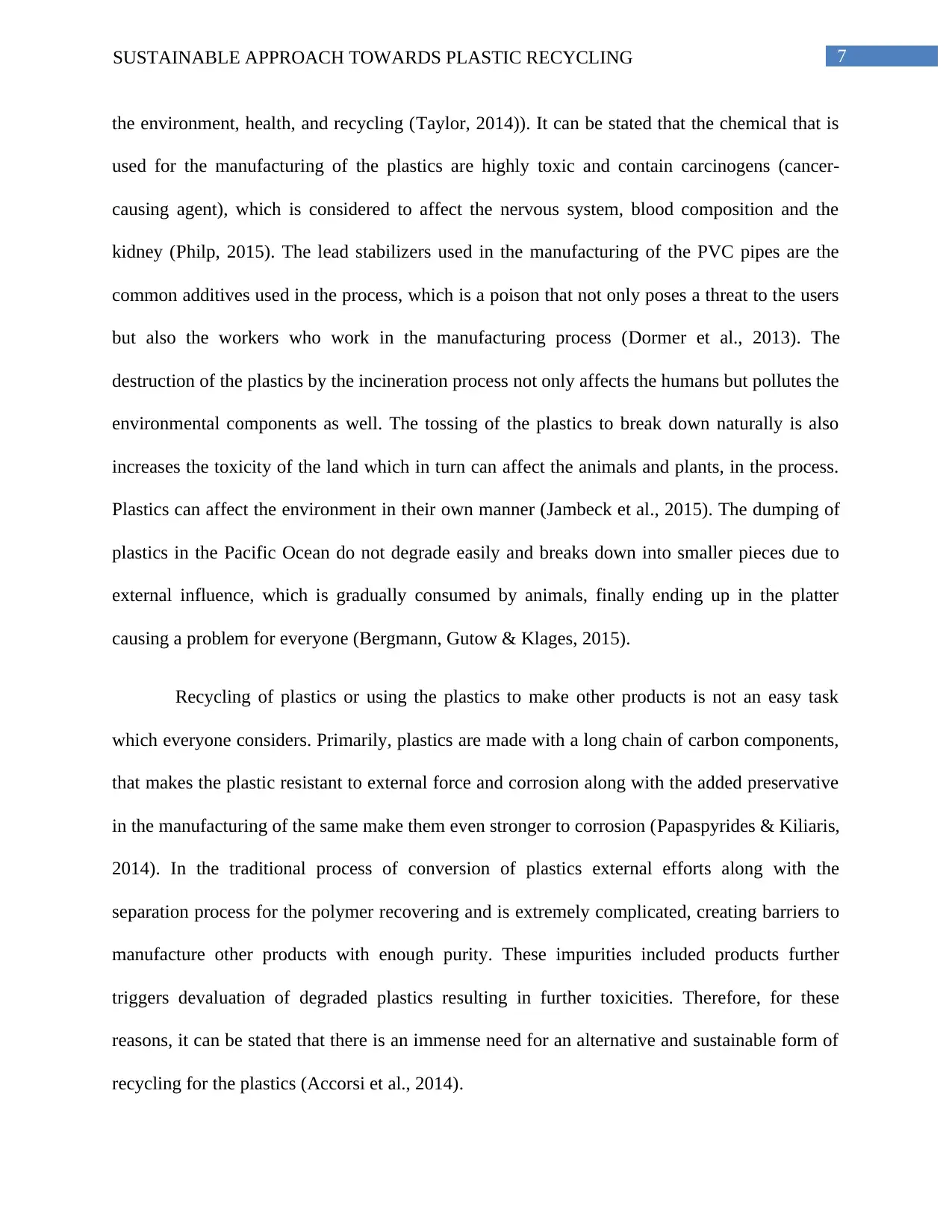
7SUSTAINABLE APPROACH TOWARDS PLASTIC RECYCLING
the environment, health, and recycling (Taylor, 2014)). It can be stated that the chemical that is
used for the manufacturing of the plastics are highly toxic and contain carcinogens (cancer-
causing agent), which is considered to affect the nervous system, blood composition and the
kidney (Philp, 2015). The lead stabilizers used in the manufacturing of the PVC pipes are the
common additives used in the process, which is a poison that not only poses a threat to the users
but also the workers who work in the manufacturing process (Dormer et al., 2013). The
destruction of the plastics by the incineration process not only affects the humans but pollutes the
environmental components as well. The tossing of the plastics to break down naturally is also
increases the toxicity of the land which in turn can affect the animals and plants, in the process.
Plastics can affect the environment in their own manner (Jambeck et al., 2015). The dumping of
plastics in the Pacific Ocean do not degrade easily and breaks down into smaller pieces due to
external influence, which is gradually consumed by animals, finally ending up in the platter
causing a problem for everyone (Bergmann, Gutow & Klages, 2015).
Recycling of plastics or using the plastics to make other products is not an easy task
which everyone considers. Primarily, plastics are made with a long chain of carbon components,
that makes the plastic resistant to external force and corrosion along with the added preservative
in the manufacturing of the same make them even stronger to corrosion (Papaspyrides & Kiliaris,
2014). In the traditional process of conversion of plastics external efforts along with the
separation process for the polymer recovering and is extremely complicated, creating barriers to
manufacture other products with enough purity. These impurities included products further
triggers devaluation of degraded plastics resulting in further toxicities. Therefore, for these
reasons, it can be stated that there is an immense need for an alternative and sustainable form of
recycling for the plastics (Accorsi et al., 2014).
the environment, health, and recycling (Taylor, 2014)). It can be stated that the chemical that is
used for the manufacturing of the plastics are highly toxic and contain carcinogens (cancer-
causing agent), which is considered to affect the nervous system, blood composition and the
kidney (Philp, 2015). The lead stabilizers used in the manufacturing of the PVC pipes are the
common additives used in the process, which is a poison that not only poses a threat to the users
but also the workers who work in the manufacturing process (Dormer et al., 2013). The
destruction of the plastics by the incineration process not only affects the humans but pollutes the
environmental components as well. The tossing of the plastics to break down naturally is also
increases the toxicity of the land which in turn can affect the animals and plants, in the process.
Plastics can affect the environment in their own manner (Jambeck et al., 2015). The dumping of
plastics in the Pacific Ocean do not degrade easily and breaks down into smaller pieces due to
external influence, which is gradually consumed by animals, finally ending up in the platter
causing a problem for everyone (Bergmann, Gutow & Klages, 2015).
Recycling of plastics or using the plastics to make other products is not an easy task
which everyone considers. Primarily, plastics are made with a long chain of carbon components,
that makes the plastic resistant to external force and corrosion along with the added preservative
in the manufacturing of the same make them even stronger to corrosion (Papaspyrides & Kiliaris,
2014). In the traditional process of conversion of plastics external efforts along with the
separation process for the polymer recovering and is extremely complicated, creating barriers to
manufacture other products with enough purity. These impurities included products further
triggers devaluation of degraded plastics resulting in further toxicities. Therefore, for these
reasons, it can be stated that there is an immense need for an alternative and sustainable form of
recycling for the plastics (Accorsi et al., 2014).
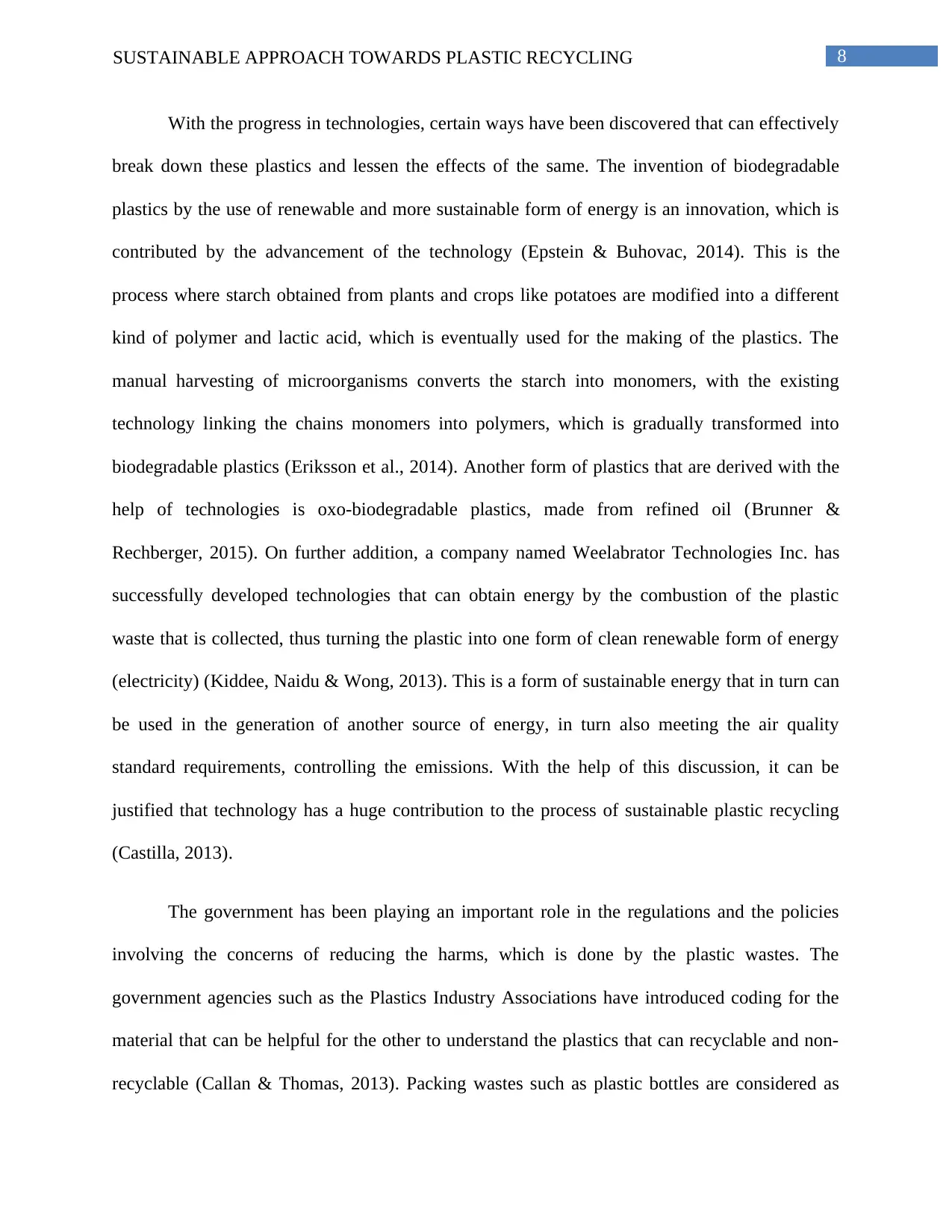
8SUSTAINABLE APPROACH TOWARDS PLASTIC RECYCLING
With the progress in technologies, certain ways have been discovered that can effectively
break down these plastics and lessen the effects of the same. The invention of biodegradable
plastics by the use of renewable and more sustainable form of energy is an innovation, which is
contributed by the advancement of the technology (Epstein & Buhovac, 2014). This is the
process where starch obtained from plants and crops like potatoes are modified into a different
kind of polymer and lactic acid, which is eventually used for the making of the plastics. The
manual harvesting of microorganisms converts the starch into monomers, with the existing
technology linking the chains monomers into polymers, which is gradually transformed into
biodegradable plastics (Eriksson et al., 2014). Another form of plastics that are derived with the
help of technologies is oxo-biodegradable plastics, made from refined oil (Brunner &
Rechberger, 2015). On further addition, a company named Weelabrator Technologies Inc. has
successfully developed technologies that can obtain energy by the combustion of the plastic
waste that is collected, thus turning the plastic into one form of clean renewable form of energy
(electricity) (Kiddee, Naidu & Wong, 2013). This is a form of sustainable energy that in turn can
be used in the generation of another source of energy, in turn also meeting the air quality
standard requirements, controlling the emissions. With the help of this discussion, it can be
justified that technology has a huge contribution to the process of sustainable plastic recycling
(Castilla, 2013).
The government has been playing an important role in the regulations and the policies
involving the concerns of reducing the harms, which is done by the plastic wastes. The
government agencies such as the Plastics Industry Associations have introduced coding for the
material that can be helpful for the other to understand the plastics that can recyclable and non-
recyclable (Callan & Thomas, 2013). Packing wastes such as plastic bottles are considered as
With the progress in technologies, certain ways have been discovered that can effectively
break down these plastics and lessen the effects of the same. The invention of biodegradable
plastics by the use of renewable and more sustainable form of energy is an innovation, which is
contributed by the advancement of the technology (Epstein & Buhovac, 2014). This is the
process where starch obtained from plants and crops like potatoes are modified into a different
kind of polymer and lactic acid, which is eventually used for the making of the plastics. The
manual harvesting of microorganisms converts the starch into monomers, with the existing
technology linking the chains monomers into polymers, which is gradually transformed into
biodegradable plastics (Eriksson et al., 2014). Another form of plastics that are derived with the
help of technologies is oxo-biodegradable plastics, made from refined oil (Brunner &
Rechberger, 2015). On further addition, a company named Weelabrator Technologies Inc. has
successfully developed technologies that can obtain energy by the combustion of the plastic
waste that is collected, thus turning the plastic into one form of clean renewable form of energy
(electricity) (Kiddee, Naidu & Wong, 2013). This is a form of sustainable energy that in turn can
be used in the generation of another source of energy, in turn also meeting the air quality
standard requirements, controlling the emissions. With the help of this discussion, it can be
justified that technology has a huge contribution to the process of sustainable plastic recycling
(Castilla, 2013).
The government has been playing an important role in the regulations and the policies
involving the concerns of reducing the harms, which is done by the plastic wastes. The
government agencies such as the Plastics Industry Associations have introduced coding for the
material that can be helpful for the other to understand the plastics that can recyclable and non-
recyclable (Callan & Thomas, 2013). Packing wastes such as plastic bottles are considered as
⊘ This is a preview!⊘
Do you want full access?
Subscribe today to unlock all pages.

Trusted by 1+ million students worldwide
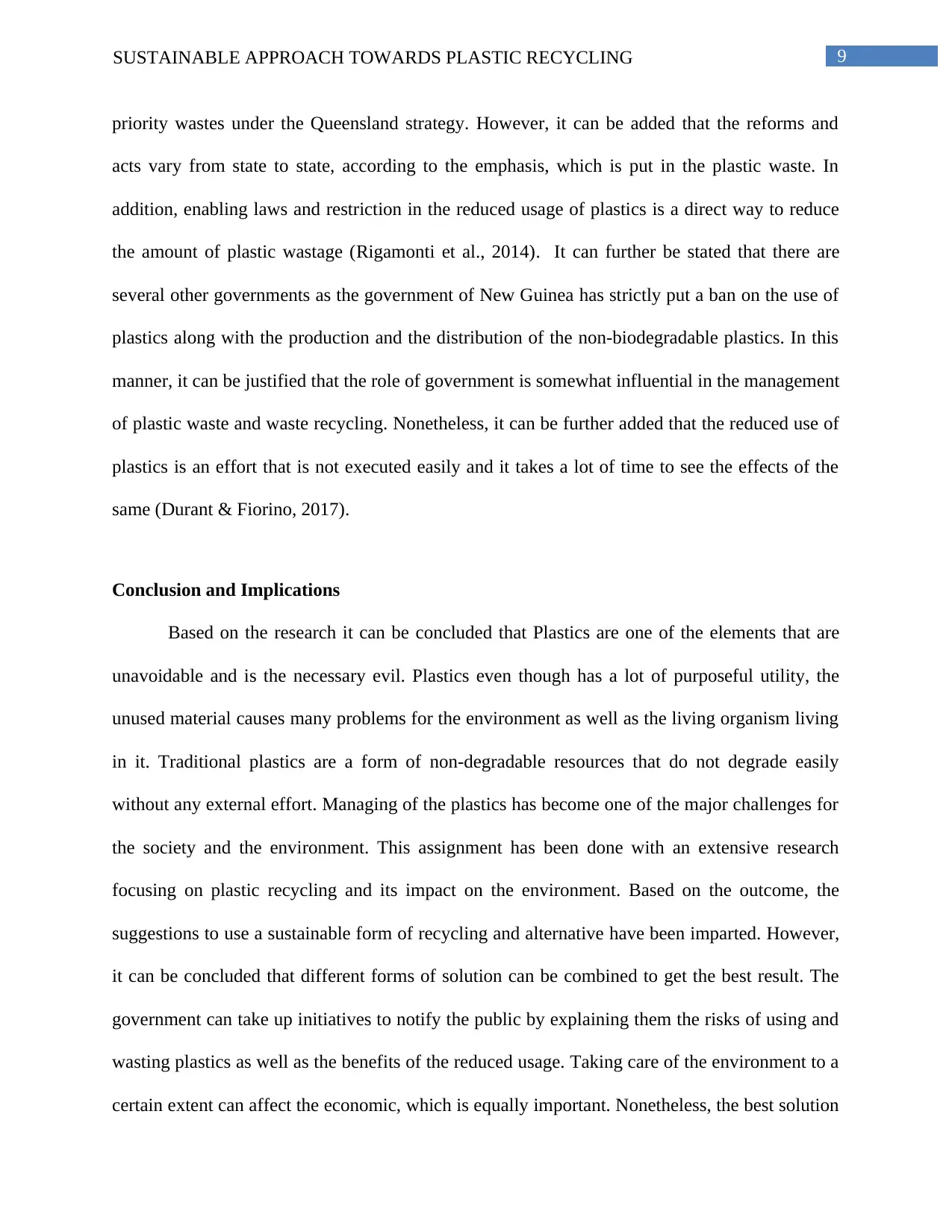
9SUSTAINABLE APPROACH TOWARDS PLASTIC RECYCLING
priority wastes under the Queensland strategy. However, it can be added that the reforms and
acts vary from state to state, according to the emphasis, which is put in the plastic waste. In
addition, enabling laws and restriction in the reduced usage of plastics is a direct way to reduce
the amount of plastic wastage (Rigamonti et al., 2014). It can further be stated that there are
several other governments as the government of New Guinea has strictly put a ban on the use of
plastics along with the production and the distribution of the non-biodegradable plastics. In this
manner, it can be justified that the role of government is somewhat influential in the management
of plastic waste and waste recycling. Nonetheless, it can be further added that the reduced use of
plastics is an effort that is not executed easily and it takes a lot of time to see the effects of the
same (Durant & Fiorino, 2017).
Conclusion and Implications
Based on the research it can be concluded that Plastics are one of the elements that are
unavoidable and is the necessary evil. Plastics even though has a lot of purposeful utility, the
unused material causes many problems for the environment as well as the living organism living
in it. Traditional plastics are a form of non-degradable resources that do not degrade easily
without any external effort. Managing of the plastics has become one of the major challenges for
the society and the environment. This assignment has been done with an extensive research
focusing on plastic recycling and its impact on the environment. Based on the outcome, the
suggestions to use a sustainable form of recycling and alternative have been imparted. However,
it can be concluded that different forms of solution can be combined to get the best result. The
government can take up initiatives to notify the public by explaining them the risks of using and
wasting plastics as well as the benefits of the reduced usage. Taking care of the environment to a
certain extent can affect the economic, which is equally important. Nonetheless, the best solution
priority wastes under the Queensland strategy. However, it can be added that the reforms and
acts vary from state to state, according to the emphasis, which is put in the plastic waste. In
addition, enabling laws and restriction in the reduced usage of plastics is a direct way to reduce
the amount of plastic wastage (Rigamonti et al., 2014). It can further be stated that there are
several other governments as the government of New Guinea has strictly put a ban on the use of
plastics along with the production and the distribution of the non-biodegradable plastics. In this
manner, it can be justified that the role of government is somewhat influential in the management
of plastic waste and waste recycling. Nonetheless, it can be further added that the reduced use of
plastics is an effort that is not executed easily and it takes a lot of time to see the effects of the
same (Durant & Fiorino, 2017).
Conclusion and Implications
Based on the research it can be concluded that Plastics are one of the elements that are
unavoidable and is the necessary evil. Plastics even though has a lot of purposeful utility, the
unused material causes many problems for the environment as well as the living organism living
in it. Traditional plastics are a form of non-degradable resources that do not degrade easily
without any external effort. Managing of the plastics has become one of the major challenges for
the society and the environment. This assignment has been done with an extensive research
focusing on plastic recycling and its impact on the environment. Based on the outcome, the
suggestions to use a sustainable form of recycling and alternative have been imparted. However,
it can be concluded that different forms of solution can be combined to get the best result. The
government can take up initiatives to notify the public by explaining them the risks of using and
wasting plastics as well as the benefits of the reduced usage. Taking care of the environment to a
certain extent can affect the economic, which is equally important. Nonetheless, the best solution
Paraphrase This Document
Need a fresh take? Get an instant paraphrase of this document with our AI Paraphraser
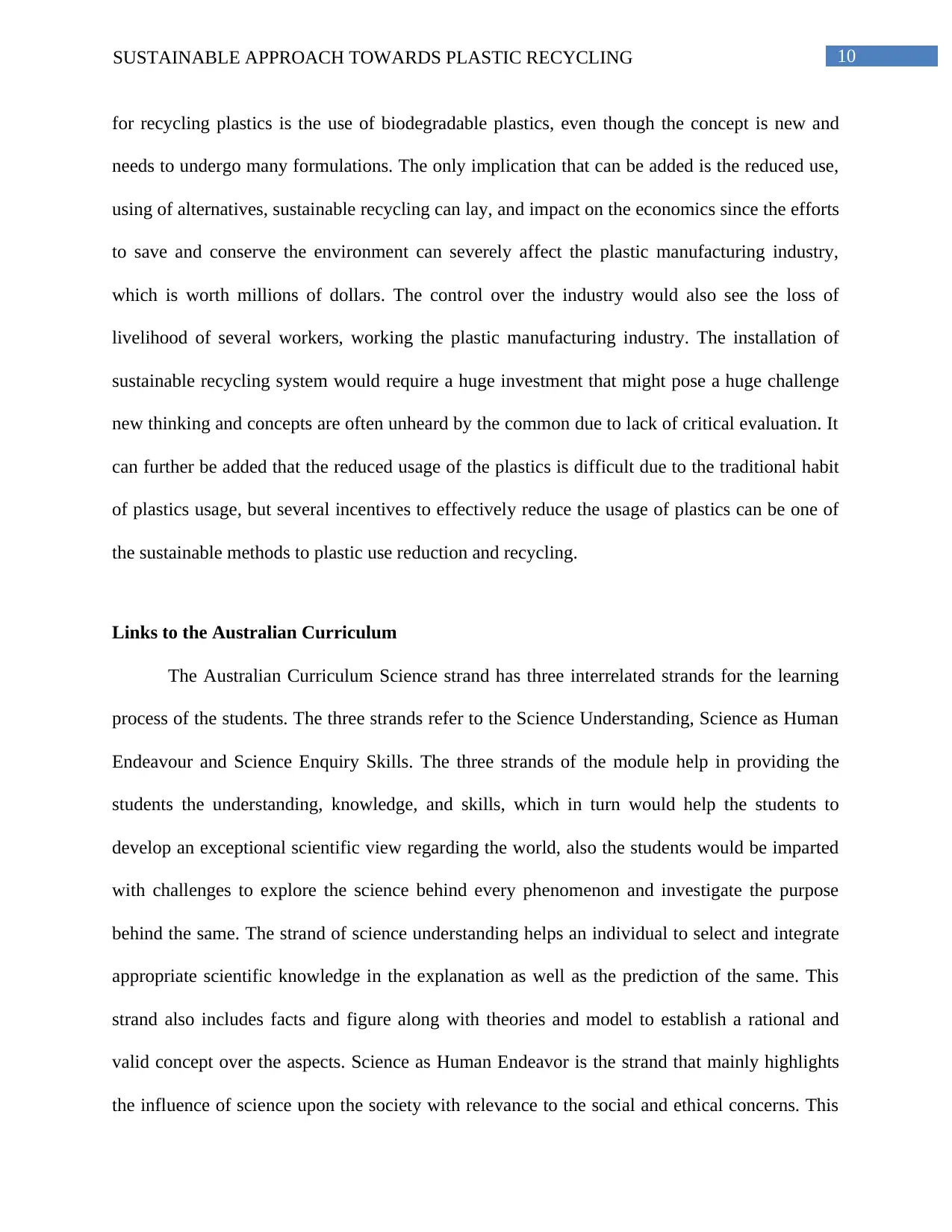
10SUSTAINABLE APPROACH TOWARDS PLASTIC RECYCLING
for recycling plastics is the use of biodegradable plastics, even though the concept is new and
needs to undergo many formulations. The only implication that can be added is the reduced use,
using of alternatives, sustainable recycling can lay, and impact on the economics since the efforts
to save and conserve the environment can severely affect the plastic manufacturing industry,
which is worth millions of dollars. The control over the industry would also see the loss of
livelihood of several workers, working the plastic manufacturing industry. The installation of
sustainable recycling system would require a huge investment that might pose a huge challenge
new thinking and concepts are often unheard by the common due to lack of critical evaluation. It
can further be added that the reduced usage of the plastics is difficult due to the traditional habit
of plastics usage, but several incentives to effectively reduce the usage of plastics can be one of
the sustainable methods to plastic use reduction and recycling.
Links to the Australian Curriculum
The Australian Curriculum Science strand has three interrelated strands for the learning
process of the students. The three strands refer to the Science Understanding, Science as Human
Endeavour and Science Enquiry Skills. The three strands of the module help in providing the
students the understanding, knowledge, and skills, which in turn would help the students to
develop an exceptional scientific view regarding the world, also the students would be imparted
with challenges to explore the science behind every phenomenon and investigate the purpose
behind the same. The strand of science understanding helps an individual to select and integrate
appropriate scientific knowledge in the explanation as well as the prediction of the same. This
strand also includes facts and figure along with theories and model to establish a rational and
valid concept over the aspects. Science as Human Endeavor is the strand that mainly highlights
the influence of science upon the society with relevance to the social and ethical concerns. This
for recycling plastics is the use of biodegradable plastics, even though the concept is new and
needs to undergo many formulations. The only implication that can be added is the reduced use,
using of alternatives, sustainable recycling can lay, and impact on the economics since the efforts
to save and conserve the environment can severely affect the plastic manufacturing industry,
which is worth millions of dollars. The control over the industry would also see the loss of
livelihood of several workers, working the plastic manufacturing industry. The installation of
sustainable recycling system would require a huge investment that might pose a huge challenge
new thinking and concepts are often unheard by the common due to lack of critical evaluation. It
can further be added that the reduced usage of the plastics is difficult due to the traditional habit
of plastics usage, but several incentives to effectively reduce the usage of plastics can be one of
the sustainable methods to plastic use reduction and recycling.
Links to the Australian Curriculum
The Australian Curriculum Science strand has three interrelated strands for the learning
process of the students. The three strands refer to the Science Understanding, Science as Human
Endeavour and Science Enquiry Skills. The three strands of the module help in providing the
students the understanding, knowledge, and skills, which in turn would help the students to
develop an exceptional scientific view regarding the world, also the students would be imparted
with challenges to explore the science behind every phenomenon and investigate the purpose
behind the same. The strand of science understanding helps an individual to select and integrate
appropriate scientific knowledge in the explanation as well as the prediction of the same. This
strand also includes facts and figure along with theories and model to establish a rational and
valid concept over the aspects. Science as Human Endeavor is the strand that mainly highlights
the influence of science upon the society with relevance to the social and ethical concerns. This
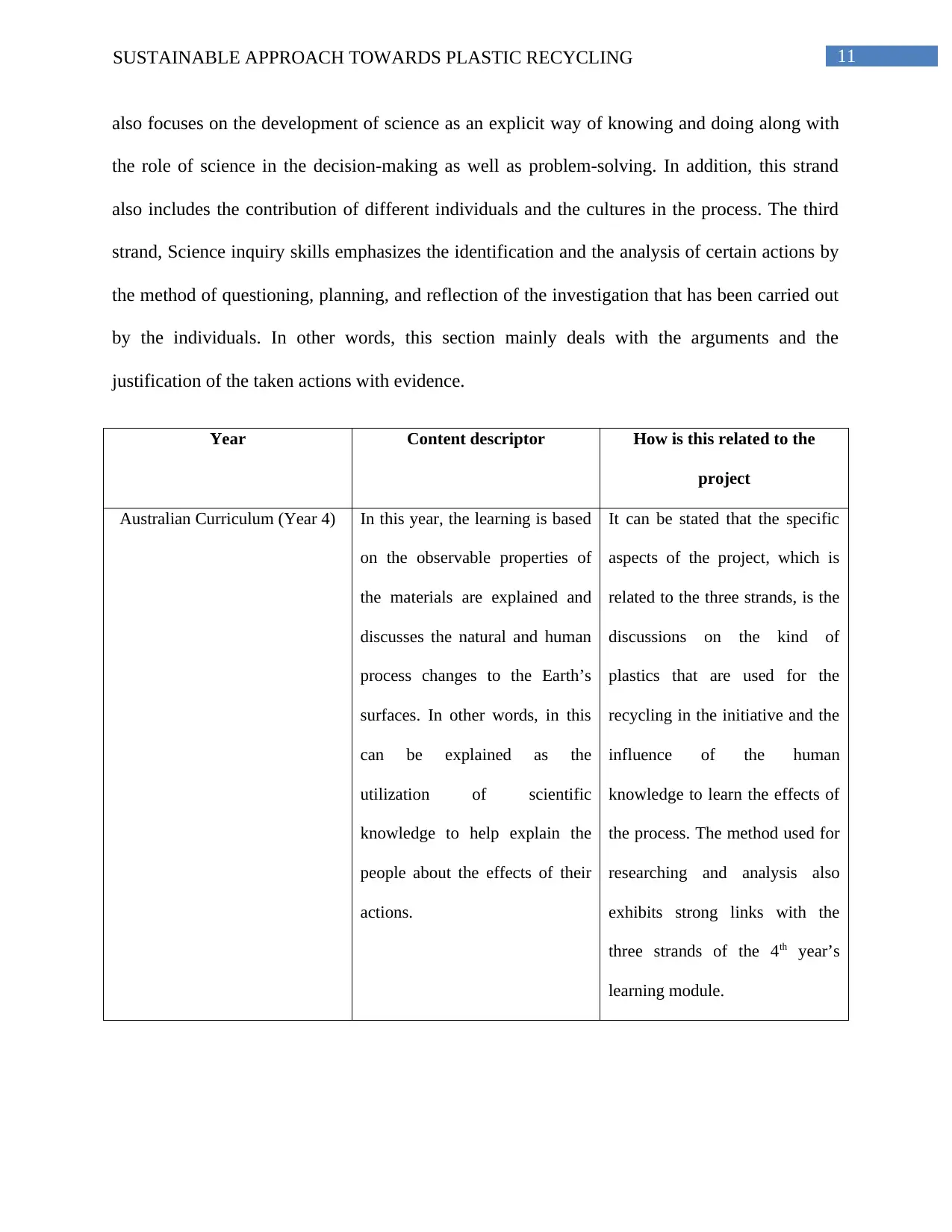
11SUSTAINABLE APPROACH TOWARDS PLASTIC RECYCLING
also focuses on the development of science as an explicit way of knowing and doing along with
the role of science in the decision-making as well as problem-solving. In addition, this strand
also includes the contribution of different individuals and the cultures in the process. The third
strand, Science inquiry skills emphasizes the identification and the analysis of certain actions by
the method of questioning, planning, and reflection of the investigation that has been carried out
by the individuals. In other words, this section mainly deals with the arguments and the
justification of the taken actions with evidence.
Year Content descriptor How is this related to the
project
Australian Curriculum (Year 4) In this year, the learning is based
on the observable properties of
the materials are explained and
discusses the natural and human
process changes to the Earth’s
surfaces. In other words, in this
can be explained as the
utilization of scientific
knowledge to help explain the
people about the effects of their
actions.
It can be stated that the specific
aspects of the project, which is
related to the three strands, is the
discussions on the kind of
plastics that are used for the
recycling in the initiative and the
influence of the human
knowledge to learn the effects of
the process. The method used for
researching and analysis also
exhibits strong links with the
three strands of the 4th year’s
learning module.
also focuses on the development of science as an explicit way of knowing and doing along with
the role of science in the decision-making as well as problem-solving. In addition, this strand
also includes the contribution of different individuals and the cultures in the process. The third
strand, Science inquiry skills emphasizes the identification and the analysis of certain actions by
the method of questioning, planning, and reflection of the investigation that has been carried out
by the individuals. In other words, this section mainly deals with the arguments and the
justification of the taken actions with evidence.
Year Content descriptor How is this related to the
project
Australian Curriculum (Year 4) In this year, the learning is based
on the observable properties of
the materials are explained and
discusses the natural and human
process changes to the Earth’s
surfaces. In other words, in this
can be explained as the
utilization of scientific
knowledge to help explain the
people about the effects of their
actions.
It can be stated that the specific
aspects of the project, which is
related to the three strands, is the
discussions on the kind of
plastics that are used for the
recycling in the initiative and the
influence of the human
knowledge to learn the effects of
the process. The method used for
researching and analysis also
exhibits strong links with the
three strands of the 4th year’s
learning module.
⊘ This is a preview!⊘
Do you want full access?
Subscribe today to unlock all pages.

Trusted by 1+ million students worldwide
1 out of 16
Related Documents
Your All-in-One AI-Powered Toolkit for Academic Success.
+13062052269
info@desklib.com
Available 24*7 on WhatsApp / Email
![[object Object]](/_next/static/media/star-bottom.7253800d.svg)
Unlock your academic potential
Copyright © 2020–2025 A2Z Services. All Rights Reserved. Developed and managed by ZUCOL.





